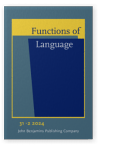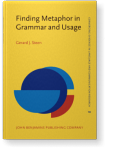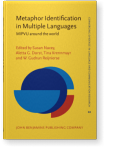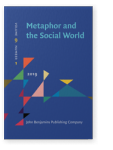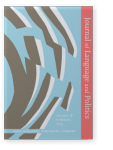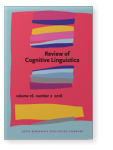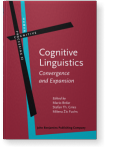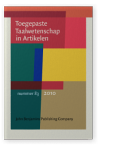Gerard J. Steen
List of John Benjamins publications for which Gerard J. Steen plays a role.
Yearbook
Journals
ISSN 0929-998X | E-ISSN 1569-9765
ISSN 2210-4070 | E-ISSN 2210-4097
ISSN 1877-9751 | E-ISSN 1877-976X
Book series
ISSN 1879-8047
ISSN 2405-6944
Slowing Metaphor Down: Elaborating Deliberate Metaphor Theory
Gerard J. Steen
[Converging Evidence in Language and Communication Research, 26] 2023. xv, 355 pp.
Subjects Cognition and language | Discourse studies | Pragmatics | Semantics | Theoretical linguistics
Dynamism in Metaphor and Beyond
Edited by Herbert L. Colston, Teenie Matlock and Gerard J. Steen
[Metaphor in Language, Cognition, and Communication, 9] 2022. vii, 359 pp.
Subjects Cognition and language | Communication Studies | Theoretical linguistics
Perspectives on Abstract Concepts: Cognition, language and communication
Edited by Marianna Bolognesi and Gerard J. Steen
[Human Cognitive Processing, 65] 2019. xii, 315 pp.
Subjects Cognition and language | Cognitive linguistics | Psycholinguistics
Visual Metaphor: Structure and process
Edited by Gerard J. Steen
[Converging Evidence in Language and Communication Research, 18] 2018. vii, 198 pp.
Subjects Cognition and language | Psycholinguistics | Theoretical linguistics
A Method for Linguistic Metaphor Identification: From MIP to MIPVU
Gerard J. Steen, Aletta G. Dorst, J. Berenike Herrmann, Anna A. Kaal, Tina Krennmayr and Tryntje Pasma
[Converging Evidence in Language and Communication Research, 14] 2010. xi, 238 pp.
Subjects Cognitive linguistics | Discourse studies | Pragmatics
Structural-Functional Studies in English Grammar: In honour of Lachlan Mackenzie
Edited by Mike Hannay and Gerard J. Steen
[Studies in Language Companion Series, 83] 2007. vi, 393 pp.
Subjects English linguistics | Functional linguistics | Germanic linguistics | Theoretical linguistics
Finding Metaphor in Grammar and Usage: A methodological analysis of theory and research
Gerard J. Steen
[Converging Evidence in Language and Communication Research, 10] 2007. xvi, 430 pp.
Subjects Cognition and language | Cognitive linguistics
The Psychology and Sociology of Literature: In honor of Elrud Ibsch
Edited by Dick Schram and Gerard J. Steen
[Utrecht Publications in General and Comparative Literature, 35] 2001. viii, 478 pp.
Subjects Theoretical literature & literary studies
Metaphor in Cognitive Linguistics: Selected papers from the 5th International Cognitive Linguistics Conference, Amsterdam, 1997
Edited by Raymond W. Gibbs, Jr. and Gerard J. Steen
[Current Issues in Linguistic Theory, 175] 1999. viii, 226 pp.
Subjects Cognition and language | Discourse studies | Pragmatics | Semantics
2022 Introduction Dynamism in Metaphor and Beyond, Colston, Herbert L., Teenie Matlock and Gerard J. Steen (eds.), pp. 11–28 | Introduction
2022 Metaphor in The Cancer Poetry Project Dynamism in Metaphor and Beyond, Colston, Herbert L., Teenie Matlock and Gerard J. Steen (eds.), pp. 31–44 | Chapter
In this paper I discuss the relation between metaphor and its role in the poetry written by cancer patients and their caregivers as reflected in the two volumes of The Cancer Poetry Project, edited by Karen Miller. I suggest that metaphor may be less important than is assumed by either Susan… read more
2021 How do scientists criticize the computer metaphor of the brain? Using an argumentative pattern for reconstructing resistance to metaphor Journal of Argumentation in Context 10:2, pp. 171–201 | Article
The central metaphor in cognitive science is the computer metaphor of the brain. In previous work, we reconstructed the metaphor in a novel way, guided by the assumption that it functions as an explanatory hypothesis. We developed an argumentative pattern for justifying scientific explanations… read more
2020 The role of co-text in the analysis of potentially deliberate metaphor Drawing Attention to Metaphor: Case studies across time periods, cultures and modalities, Di Biase-Dyson, Camilla and Markus Egg (eds.), pp. 15–38 | Chapter
Taking Deliberate Metaphor Theory (Steen, 2015) as a starting point, this chapter investigates the way in which co-text influences the identification and analysis of potentially deliberate metaphor in discourse. While co-text plays a role in the identification and analysis of the linguistic and… read more
2020 Violence metaphors for cancer: Pragmatic and symptomatic arguments against Metaphor and the Social World 10:1, pp. 121–140 | Article
The use of violence metaphors for cancer has been widely criticised both in academic and non-academic contexts (see Harrington, 2012; Semino et al., 2015). Whereas previous research on violence metaphors for cancer has focused on the use and functions of these metaphors by and for different… read more
2019 Introduction Perspectives on Abstract Concepts: Cognition, language and communication, Bolognesi, Marianna and Gerard J. Steen (eds.), pp. 1–13 | Chapter
2019 An argumentative reconstruction of the computer metaphor of the brain Journal of Argumentation in Context 8:3, pp. 317–335 | Article
The computer metaphor of the brain is frequently criticized by scientists and philosophers outside the computational paradigm. Proponents of the metaphor may then seek to defend its explanatory merits, in which case the metaphor functions as a standpoint. Insofar as previous research in… read more
2019 Chapter 1. MIPVU in multiple languages Metaphor Identification in Multiple Languages: MIPVU around the world, Nacey, Susan, Aletta G. Dorst, Tina Krennmayr and W. Gudrun Reijnierse (eds.), pp. 1–21 | Chapter
2019 Figurative analogies and how they are resisted in British Public Bill Committee debates Metaphor and the Social World 9:1, pp. 107–130 | Article
This paper studies metaphor use in British Public Bill Committee debates. It focuses on the way in which legislators frame their arguments in metaphorical terms under the form of figurative analogies. Because these figurative analogies can be misleading by oversimplifying the issue under… read more
2019 I did not say that the government should be plundering anybody’s savings: Resistance to metaphors expressing starting points in parliamentary debates Journal of Language and Politics 18:5, pp. 718–738 | Article
This paper examines how politicians employ metaphors to express starting points in British parliamentary debates. Because these metaphors are conceptual tools that may have presuppositions and entailments that are not in line with the ideas and values of all discussion parties, political… read more
2019 Chapter 2. MIPVU: A manual for identifying metaphor-related words Metaphor Identification in Multiple Languages: MIPVU around the world, Nacey, Susan, Aletta G. Dorst, Tina Krennmayr and W. Gudrun Reijnierse (eds.), pp. 23–40 | Chapter
2018 On metaphorical views, dynamite, and doodlings: Functions of domain adjectives in metaphorical domain constructions Review of Cognitive Linguistics 16:2, pp. 431–454 | Article
This paper offers a systematic, bottom-up, investigation of the role of adjectives as metaphor signals in metaphorical domain constructions (MDCs) such as ‘budgetary anorexia’ and ‘economic crash’ within the framework of Deliberate Metaphor Theory (e.g., Steen, 2017). To this end, we analyse all… read more
2018 Chapter 8. Conclusion Visual Metaphor: Structure and process, Steen, Gerard J. (ed.), pp. 185–196 | Chapter
2018 Chapter 5. Behavioral evidence for VISMIP Visual Metaphor: Structure and process, Steen, Gerard J. (ed.), pp. 117–146 | Chapter
2018 Chapter 3. VISMIP: Towards a method for visual metaphor identification Visual Metaphor: Structure and process, Steen, Gerard J. (ed.), pp. 47–88 | Chapter
2017 Chapter 4. Introducing a three-dimensional model of verbal irony: Irony in language, in thought, and in communication Irony in Language Use and Communication, Athanasiadou, Angeliki and Herbert L. Colston (eds.), pp. 87–108 | Chapter
We introduce a three-dimensional model for irony research, which is an extension of Steen’s (2008, 2011) three-dimensional model of metaphor and similarly argues that the study of irony requires three distinct dimensions: (1) language, (2) thought and (3) communication. Irony in language requires… read more
2016 Chapter 6. Mixed metaphor is a question of deliberateness Mixing Metaphor, Gibbs, Jr., Raymond W. (ed.), pp. 113–132 | Article
This paper aims to explore the interaction between mixed metaphor and deliberateness in order to throw some new light on the nature of mixed metaphor. The basic claim is that the typical or strongest experience of mixed metaphor arises when two metaphors conflict that are both used deliberately as… read more
2015 How viruses and beasts affect our opinions (or not): The role of extendedness in metaphorical framing The political impact of metaphors, Perrez, Julien and Min Reuchamps (eds.), pp. 245–263 | Article
Based on the assumption that extended metaphor may constitute a case of deliberate metaphor and therefore has the potential to influence people’s opinions, this paper investigates whether extending a metaphorical frame in a text leads people to perceive policy measures that are in line with that… read more
2014 Economic competition is like auto racing: Building metaphorical schemas when reading text Metaphor and the Social World 4:1, pp. 65–89 | Article
Even though our language is pervaded by metaphor, we do not necessarily think metaphorically. Knowing whether people make conceptual connections between a source and a target domain, and if so under which conditions, is of theoretical as well as practical interest, for example in text design. This… read more
2013 The contemporary theory of metaphor — now new and improved! Metaphor and Metonymy revisited beyond the Contemporary Theory of Metaphor: Recent developments and applications, Gonzálvez-García, Francisco, María Sandra Peña-Cervel and Lorena Pérez-Hernández (eds.), pp. 27–65 | Article
This paper outlines a multi-dimensional/multi-disciplinary framework for the study of metaphor. It expands on the cognitive linguistic approach to metaphor in language and thought by adding the dimension of communication, and it expands on the predominantly linguistic and psychological approaches… read more
2013 Processing visual metaphor: A study in thinking out loud Metaphor and the Social World 3:1, pp. 1–34 | Article
This article explores the mental operations people undertake when they encounter a visual metaphor. First, an integrated theoretical model of visual metaphor processing is proposed. The model is then empirically evaluated: in a think aloud task, six participants were presented with twelve pictures… read more
2011 Recognition of personifications in fiction by non-expert readers Metaphor and the Social World 1:2, pp. 174–200 | Article
This paper offers an integrated typology for the classification of personifications in discourse, based on existing methods for linguistic metaphor identification such as MIP (Pragglejaz Group, 2007) and MIPVU (Steen et al., 2010). The psychological relevance of the proposed typology is explored… read more
2011 Genre between the humanities and the sciences Bi-Directionality in the Cognitive Sciences: Avenues, challenges, and limitations, Callies, Marcus, Wolfram R. Keller and Astrid Lohöfer (eds.), pp. 21–42 | Article
This chapter outlines an approach to genre as the driving force behind language, cognition, and communication. Genre can and has been studied in the humanities as well as the cognitive and social sciences, but the present chapter presents a theoretical integration of these approaches and offers a… read more
2011 Issues in collecting converging evidence: Is metaphor always a matter of thought? Converging Evidence: Methodological and theoretical issues for linguistic research, Schönefeld, Doris (ed.), pp. 33–54 | Article
In empirical research, metaphor constitutes a showcase for the difficulties involved in handling converging evidence, which typically displays a conflation between two scientific phenomena, ‘phenomenological pluralism’ and ‘methodological pluralism’. Phenomenological pluralism is exciting but… read more
2011 Metaphor in language and thought: How do we map the field? Cognitive Linguistics: Convergence and Expansion, Brdar, Mario, Stefan Th. Gries and Milena Žic Fuchs (eds.), pp. 67–86 | Article
This chapter suggests that metaphor research can benefit from a clearer description of the field of research. Three dimensions of doing metaphor research are distinguished: metaphor can be studied as part of grammar or usage, it can be studied as part of language or thought, and it can be studied… read more
2011 The contemporary theory of metaphor — now new and improved! Metaphor and metonymy revisited beyond the Contemporary Theory of Metaphor: Recent developments and applications, Gonzálvez-García, Francisco, María Sandra Peña-Cervel and Lorena Pérez-Hernández (eds.), pp. 26–64 | Article
This paper outlines a multi-dimensional/multi-disciplinary framework for the study of metaphor. It expands on the cognitive linguistic approach to metaphor in language and thought by adding the dimension of communication, and it expands on the predominantly linguistic and psychological approaches… read more
2010 Researching And Applying Metaphor Toegepaste Taalwetenschap in Artikelen 83, pp. 91–102 | Article
Metaphor has become an important area of investigation where fundamental and applied research on language and its use meet. This article presents metaphor as a rapidly developing area of study for applied linguists who are adding an interventionist dimension to the more fundamental research on… read more
2010 9. Pragglejaz in practice: Finding metaphorically used words in natural discourse Researching and Applying Metaphor in the Real World, Low, Graham, Zazie Todd, Alice Deignan and Lynne Cameron (eds.), pp. 165–184 | Article
This paper aims to present the application of a new method for metaphor identification in discourse, the Pragglejaz Metaphor Identification Procedure, in two corpus-linguistic projects. It provides background information to the method and then demonstrates its basic workings by means of three… read more
2007 Review of Kepser & Reis (2005): Linguistic evidence: Empirical, theoretical, and computational perspectives Ditransitivity, Siewierska, Anna and Willem B. Hollmann (eds.), pp. 165–171 | Review
2002 Metaphor in Bob Dylan’s “Hurricane”: Genre, language, and style Cognitive Stylistics: Language and cognition in text analysis, Semino, Elena and Jonathan Culpeper (eds.), pp. 183–209 | Chapter
2001 A rhetoric of metaphor: Conceptual and linguistic metaphor and the psychology of literature The Psychology and Sociology of Literature: In honor of Elrud Ibsch, Schram, Dick and Gerard J. Steen (eds.), pp. 145–163 | Article
2001 The empirical study of literature: Psychology, sociology, and other disciplines The Psychology and Sociology of Literature: In honor of Elrud Ibsch, Schram, Dick and Gerard J. Steen (eds.), pp. 1–16 | Article
1999 From linguistic to conceptual metaphor in five steps Metaphor in Cognitive Linguistics: Selected papers from the 5th International Cognitive Linguistics Conference, Amsterdam, 1997, Gibbs, Jr., Raymond W. and Gerard J. Steen (eds.), pp. 57–78 | Article
1999 Introduction Metaphor in Cognitive Linguistics: Selected papers from the 5th International Cognitive Linguistics Conference, Amsterdam, 1997, Gibbs, Jr., Raymond W. and Gerard J. Steen (eds.), pp. 1–8 | Article

